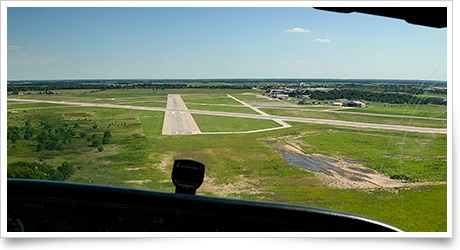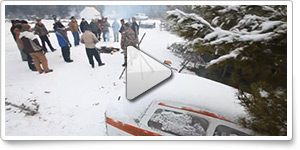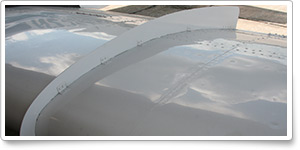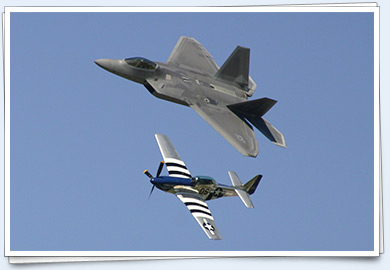| ||||||
| The long-field method |
| |||||
Training TipsThe long-field method That’s not to say that a long runway comes without its unique set of demands and considerations. Arriving from the north at New Hampshire’s Portsmouth International Airport, you find that the general aviation apron is all the way at the opposite end. That’s a long taxi, so take your time and don’t rush things. The taxi route is straightforward; at some airports navigating a daunting ground route will go smoothly if you request progressive taxi instructions. What will you do if the winds are still out of the south when you depart? A full-length departure means taxiing all the way back to the departure end; if it is a warm day, be alert of any signs of overheating that closely cowled, air-cooled engine. (If your aircraft has cowl flaps, double check that you opened them after landing.) As an alternative, you may be offered—or could request—an intersection takeoff, and you may hear and observe other aircraft preparing to depart from various points along the runway. Discuss this scenario with your flight instructor for any specific solo cross-country, and follow up with a thorough study of the airport’s taxi diagram. The Air Safety Institute offers this page for looking up your destination’s diagram. Be sure you can locate and understand signs indicating how much runway distance remains from any intersection. When departing from an intersection, pay close attention to the departure path of aircraft taking off ahead of you—especially if they are airborne when they pass your location—for the wake turbulence they could generate. If an early turn on course is indicated for safety, request it from a departure controller, or commence it from a safe altitude after takeoff from a nontowered airport. Longer runways are convenient, confidence-inspiring features of many airports you will visit, but they don’t suggest that you should relax your vigilance or ease up on your piloting technique. Flight Training NewsCombat veteran solos LSAAble Flight scholarship winner Adam Kisielewski, a former U.S. Marine sergeant who lost his left arm and part of his right leg in combat in Iraq, soloed a light sport aircraft on March 14. Kisielewski made three textbook takeoffs and landings in a modified Flight Design CTLS at Frederick Municipal Airport in Frederick, Md. His flight instructor, Dean Stickell, soloed at the same airport in 1957. Read more >> Should student pilots ask for a better runway assignment?Student pilots learn early in their training that they should depart a runway aligned into the wind as much as possible. But what if the tower clears them to depart the crosswind runway and the winds are a bit stronger than they are comfortable with? Talking to air traffic controllers is often an intimidating experience for student pilots, and they can be hesitant to ask for what they need. Should they accept the assigned runway? Listen to the newest segment of Ask ATC from the Air Safety Institute as a tower controller addresses these questions. Watch AOPA Live® >> NBAA awards international operator scholarshipsThe National Business Aviation Association has chosen three recipients for its 2012 International Operators Scholarship. They are Nikolas Bray, enrolled in the professional pilot program at the University of Oklahoma; Gregory Frister, a student at Lewis University majoring in aviation management; and Basham Johnson, a professional pilot with Jet Aviation. They will split the $13,500 scholarship for professional development toward careers in business aviation that are related to international operations. For more information on NBAA’s scholarship program, see the website. Okla. U. flight academy summer camp registration openThe University of Oklahoma Sooner Flight Academy is accepting registrations for its youth summer camps. The education outreach program is provided through the University of Oklahoma’s Department of Aviation and University Outreach. Five-day programs are available for children ages 6 to 18, in which participants learn the principles of flight using science and mathematics. Scholarships are available. Fourth-generation pilot solosA Michigan teenager is on track to be the fourth generation in his family to become a pilot. Kris Anderson soloed in December 2011 at Jack Barstow Airport in Midland. The pilots who came before him are his great-grandfather, Knute A. Anderson; grandfather, Bob Anderson; and father, Rob Anderson—all of whom were at the airport to watch Kris solo, according to the Midland Daily News. Training ResourcesSpring sprang early in many areas around the country, for the most part leaving behind the cold, ice, snow, and darkness of winter. But during the winter months many airplanes sit idle for a long time, and bad things tend to befall pilots who just “kick the tires and light the fires” on the first warm day of the year. Check out the Air Safety Institute’s Spring Preflight Safety Spotlight to get ready for the spring flying season. The spotlight gathers in one place essential courses, quizzes, publications, and links so you don’t have to.
Did you know that student pilots who join AOPA are three times more likely to complete their flight training? Membership includes unlimited access to aviation information by phone (800/USA-AOPA, weekdays from 8:30 a.m. to 6 p.m. Eastern time) or from Flight Training Online or AOPA Online. If you're not already a member, join today and get the pilot’s edge. Login information is available online. Surviving an aircraft accident Career PilotDirect Air cancels flightsDirect Air, an indirect air carrier providing public charter air flights, canceled its charter program on March 13. Direct Air does not operate its own airplanes, but instead relies on other carriers to conduct its flights. News outlets reported that two carriers said they were cutting off service to the charter because they had not been paid. The announcement left travelers stranded during the busy spring break season. Direct Air had been operating out of South Carolina to destinations in Florida, the Northeast, and the Midwest. Initial reports indicated the company may resume operations in May. Airlines vie for flights to Reagan NationalLong-haul routes from Ronald Reagan Washington National Airport are being added for the first time since 2004, and a number of airlines are scrambling for the slots. Contenders include Alaska Air, JetBlue, Southwest, and Virgin America. The new slots are made available through the FAA funding bill that was signed into law in February. The Department of Transportation is expected to make its decision in May, according to Bloomberg Businessweek. Plane SpotterSTOL aircraft: Short-field performers Training ProductsRadio Navigation Simulator app from Sporty’sIf VORs give you pause and you don’t know your distance measuring equipment (DME) from your automatic direction finder (ADF), practice is the key to mastering these navigation systems. Sporty’s Radio Navigation Simulator app shows a simulated instrument panel with a directional gyro and user-selectable course deviation indicator, radio magnetic indicator, ADF, and DME. Drag an airplane around the map, turn the OBS knob, change the map location, change navaid frequencies, and more. The app can be used on the iPhone, iPad, and iPod Touch. It sells for $9.95. See the website or call 800/776-7897.
Note: Products listed have not been evaluated by ePilot editors unless otherwise noted. AOPA assumes no responsibility for products or services listed or for claims or actions by manufacturers or vendors. Member BenefitsAircraft insurance renewal application explainedWhat information determines your insurance premium? Ninety days prior to the renewal date of your aircraft insurance policy, the AOPA Insurance Agency mails an aircraft insurance renewal application to the address listed on the policy. It is important that you review all of it and provide updated information in order to receive the best rate. Read more >> BlogsThe March ‘Since You Asked’ poll: That problem studentWhat’s a flight instructor to do with an instrument student who thinks he doesn’t need any more practice before the checkride? AOPA Technical Editor Jill Tallman discusses the results of a poll. Also in this week’s Flight Training blog, Chip Wright talks about tourists. Mrs. Alaska takes flight with 'GirlsFlyToo' platformMeet Ariel Talen-Keller—Mrs. Alaska U.S. All World Beauties pageant winner—in the Let’s Go Flying blog. Keller’s platform is a project to encourage and educate women to be a part of aviation. AOPA Career OpportunitiesEver dream of turning your passion for aviation into a career? We’re looking for a project manager of online products, aviation technical specialist, member services representative, manager of regulatory affairs, director of new market development, associate project manager, marketing specialist–products, aviation education program developer, accounting manager, and associate editor–Web/ ePilot. To learn more about other AOPA career opportunities, visit AOPA Online. Community
AVIATION EVENTS & WEATHER
| ||||||||||||||||||||||||||||||||||||




 Nothing beats making an arrival at an unfamiliar airport with an
Nothing beats making an arrival at an unfamiliar airport with an 





